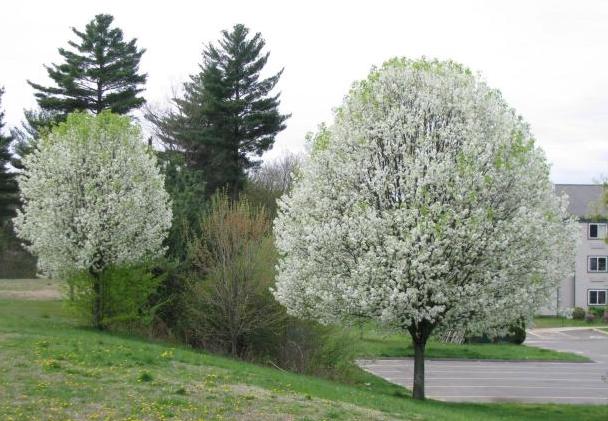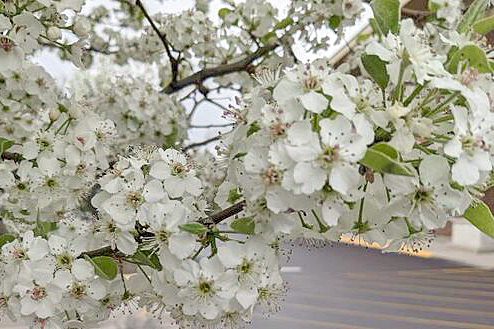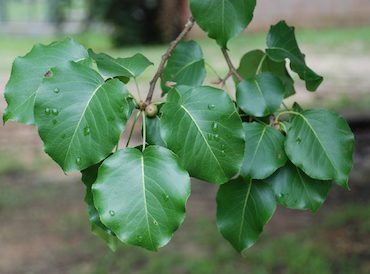Callery Pear, An Invasive Tree
by Sylvia Sloan, Fairfax Master Gardener
 It’s one of the first trees to bloom in the spring. It appears in neighborhoods, along roadsides and in woodlands in our area. It almost appears to be everywhere. I used to think it was a beautiful harbinger of spring until I learned more about it. What is it? It’s Pyrus calleryana, also known as the Callery Pear. It is native to Asia and was brought to the United States as root stock in the early 1900s because of its resistance to fireblight in European pear fruit trees.
It’s one of the first trees to bloom in the spring. It appears in neighborhoods, along roadsides and in woodlands in our area. It almost appears to be everywhere. I used to think it was a beautiful harbinger of spring until I learned more about it. What is it? It’s Pyrus calleryana, also known as the Callery Pear. It is native to Asia and was brought to the United States as root stock in the early 1900s because of its resistance to fireblight in European pear fruit trees.
‘Bradford’ Pear is the well-known cultivar of the Callery Pear and has a uniform upright shape, profuse white flowers, no thorns and bright red foliage in the fall. A fast-growing tree with spectacular although stinky spring flowers, it was planted throughout the southeast and proved to be especially popular in newly developed neighborhoods and along suburban streets. The ‘Bradford’ cultivar is unable to self-pollinate, and it was thought to be sterile since each one is a grafted tree with genetically identical upper portions. It is unable to be pollinated by other Bradford pears as well. However, as other Callery Pear cultivars, such as ‘Chanticleer’ or ‘Cleveland Select,’ ‘Autumn Blaze,’ and ‘Aristocrat’ became popular and more widely planted, these cultivars began to cross pollinate with the ‘Bradford’ Pear and produce abundant amounts of fruit that were spread by birds.

Callery Pear blossoms
The fruit grew into Callery Pear trees, offering no benefit to insects or our native wildlife. These trees in turn began to prolifically reproduce, crowding out our native species that do offer benefits. In addition, Bradford Pears can also die off, leaving the Callery Pear rootstock to then grow. They can be distinguished from the Bradfords cultivar by their thorns.
Callery Pears are outlawed in a few states, and some nurseries are banned from selling them in others. The Callery Pear is legal in our state, although placed on the Virginia invasive species list.
Not only has the Callery Pear become highly invasive, it has proven to be a poor tree choice for our landscape due to its tendency to split in moderate to high winds and ice storms. It thrives in a wide variety of environments and when it escapes cultivation, this ability to grow quickly in poor soil enables it to form dense thickets that choke out native species. It has thorns that can puncture tires making it difficult to remove. Individual small plants can be pulled by hand, but all roots must be removed because root fragments often resprout. Larger trees can be cut, but for mowing and cutting to be effective, it must be followed with an herbicide application to cut surfaces or the foliage of resprouts.

Callery Pear Leaves
How do you identify the Callery Pear? It’s usually 35 to 40 feet (10 to 12 m) high, with a spread of 25 feet (8 m). The thick waxy leaves are alternately arranged, rounded or teardrop-shaped, and approximately 1-1/2 to 3 inches (4 to 8 cm) long and wide. The leaf margin is finely toothed and has a distinct ripple or wave. The white, five-petaled flowers are held together in a ball-shaped bundle, with each flower being about 3/4 inch (2 cm) across. The blossoms produce a strong, rancid odor which has been compared to rotten fish. The fruit consists of small, hard pears each 1/2 inch (10 mm) in diameter, green to brown in color, flecked with pale dots and held in the same clusters as the blossoms. The fruit is almost woody, until softened by frost. The bark is grayish brown, smooth on young limbs, and grows deeply fissured or scaly as the tree gets larger.
If you have a Callery Pear in your yard, you may want to consider replacing it with a native alternative. Some options to consider include the following:
- Flowering Dogwood, Cornus florida
- Serviceberry, Amelanchier spp.
- Green Hawthorn, Crataegus viridis
- Chokecherry, Prunus virginiana
- White Fringe Tree, Chionanthus virginicus
- References
- Bradford Pear Bounty, About Flowering Pears, Clemson Cooperative Extension
- Bradford Callery Pear (and other cultivars) Pyrus calleryana ‘Bradford,’ Alex X. Niemera, Virginia Cooperative Extension, 3010-1464
- Callery Pear, Skylure Templeton et.al., Penn State Extension
- Callery Pear: ‘Bradford’ and Other Varieties and Their Invasive Progeny, Courtney Johnson and Kelly Oten, North Carolina State Extension